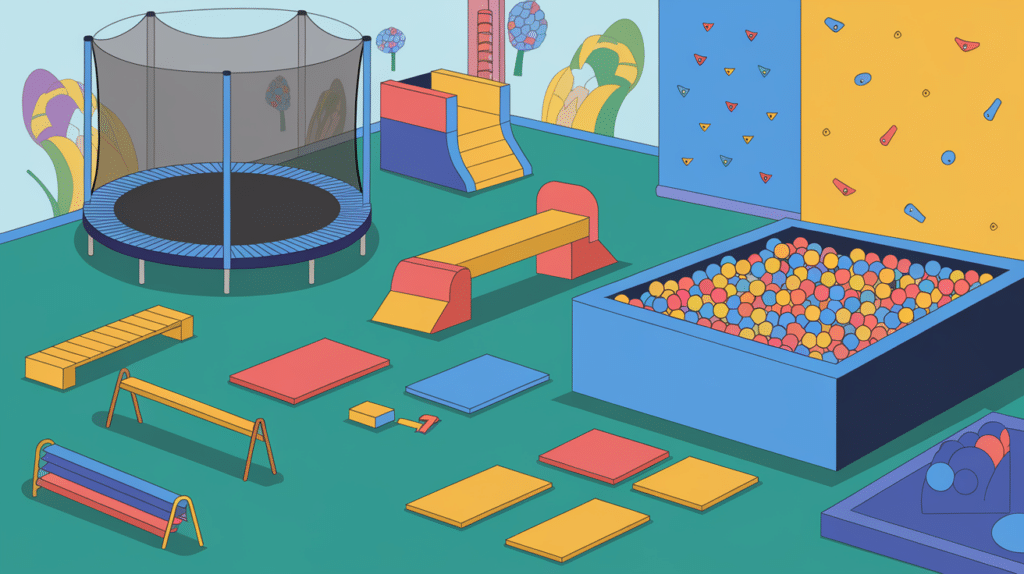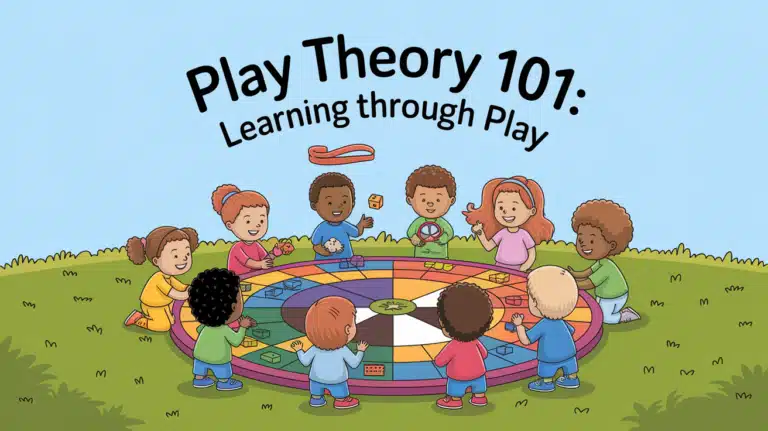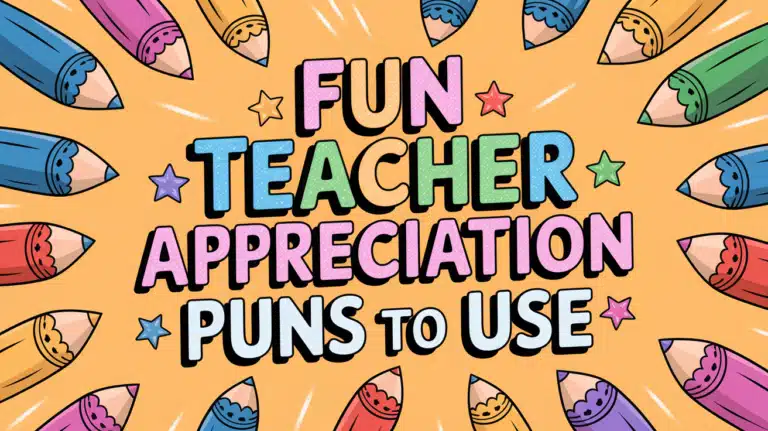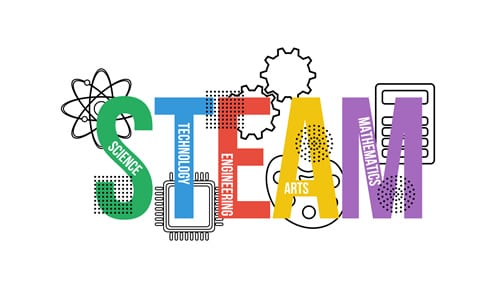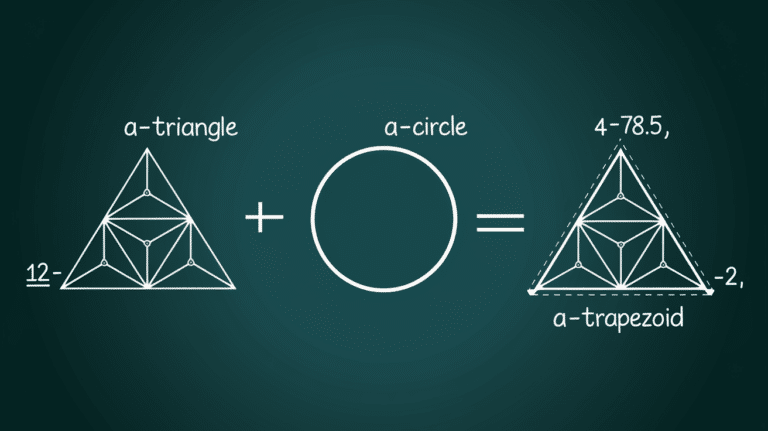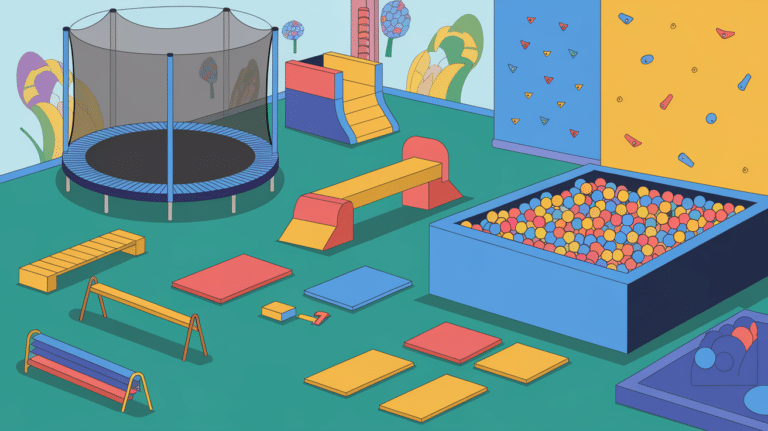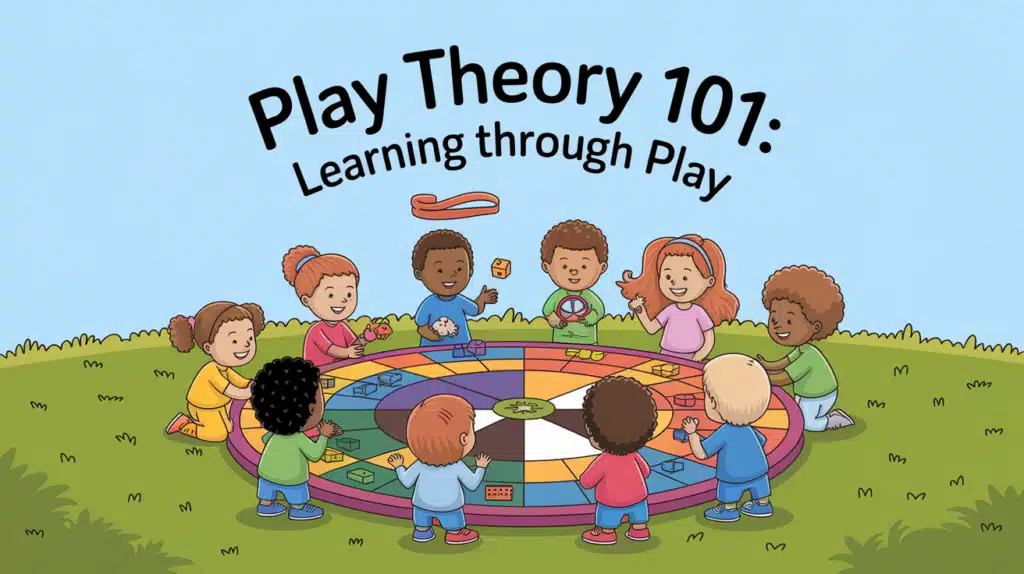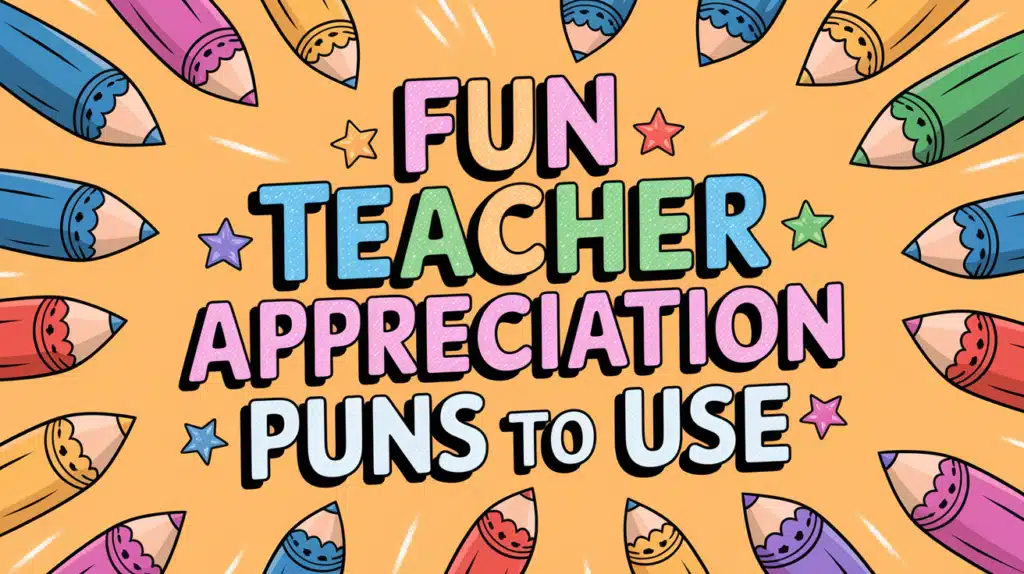Kids stuck inside again? When the weather turns bad or screen time has gone on too long, parents face a common struggle.
Children need to move their bodies, but the living room isn’t exactly a playground.
The good news? You don’t need a gym membership or fancy equipment to keep kids active indoors. With a little creativity and some basic household items, you can convert ordinary spaces into zones for movement, fun, and even learning.
These indoor physical activities for 6-12-year-olds will get hearts pumping and giggles flowing while protecting your lamps from flying balls and your sanity from the “I’m bored” chorus.
Why are Indoor Physical Activities for 6-12-year-olds Essential?
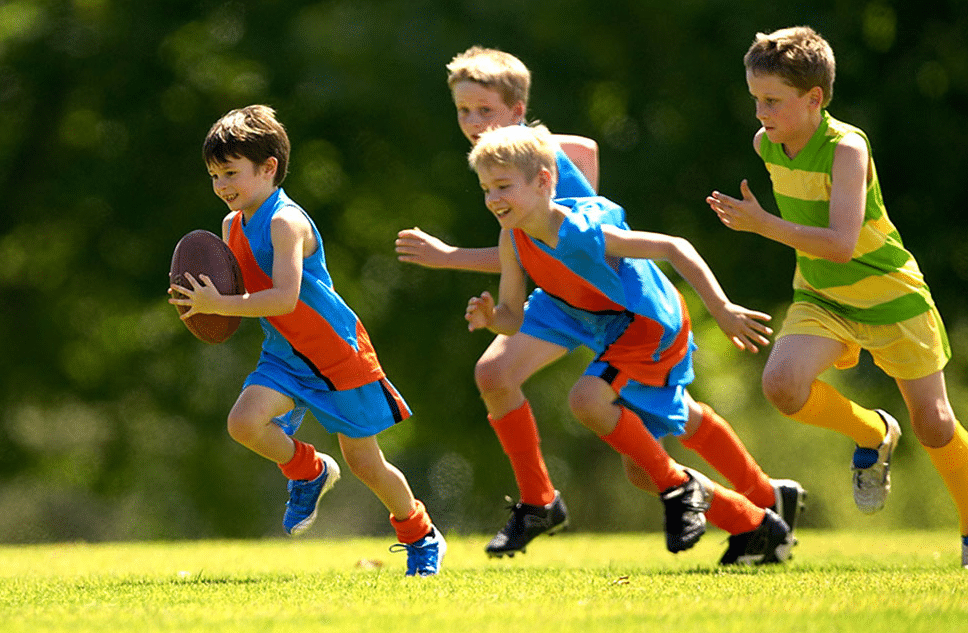
Indoor physical activities for 6-12 year olds are essential because it helps them grow strong and healthy. Here’s why it’s so important:
- Builds Strong Bones, Muscles, and Joints: Physical activity helps children develop strong bones and muscles, which are crucial for their overall growth.
- Improves Coordination and Balance: Kids who engage in physical activity develop better coordination and balance, making them more confident in daily tasks and sports.
In addition to physical health, staying active has mental benefits:
- Boosts Mood and Reduces Stress: Regular exercise can improve mood and help reduce feelings of stress, making kids happier and calmer.
- Improves Focus and Memory: Physical activity enhances cognitive functions, which can lead to better concentration and memory at school.
Also, physical activity helps with sleep. Active children tend to sleep better, which makes them more rested and ready for the day.
Lastly, exercise teaches important life skills. It encourages Teamwork and Communication. When kids play sports or games, they learn valuable social skills like teamwork, leadership, and communication.
Encouraging kids to stay active now helps them build habits that will keep them healthy as they grow older.
Fun & Active Indoor Physical Activities for 6-12-Year-Olds to Try

Looking for ways to stay active indoors? Check out a variety of fun and engaging indoor activities that will keep you moving and energized, no matter the weather.
1. Indoor Mini Basketball
Set up a mini basketball hoop on a door or wall and use a soft, small basketball. Players take turns trying to shoot the ball into the hoop from different spots.
You can add challenges like shooting from farther away or from different angles.
This game can be played alone or with friends. You’ll need a mini basketball hoop and a soft basketball, which typically cost between $20 and $50.
2. Freeze Dance
In Freeze Dance, everyone dances to music, and when the music stops, they must freeze in place. If someone moves when the music stops, they are out of the game.
It’s a fun and active game for all ages, and it only requires music and space to move. This game is completely free to play.
3. Obstacle Course Challenge
Create an obstacle course inside your home using things like pillows, chairs, and blankets.
You can set up challenges like crawling under tables, jumping over pillows, or balancing on one foot. Players race through the course to see who can finish the fastest.
The cost for setting up the course is very low, typically just using household items, but if you buy extra items like cones or inflatable obstacles, it may cost between $10 and $30.
4. Pillow Fight
In a pillow fight, players try to hit each other gently with pillows. The goal is to play without hurting anyone.
This is a simple and fun game that only requires pillows, which most people already have at home. This game is free to play and suitable for all ages.
6. Jumping Jacks Race
In this game, players see who can do the most jumping jacks in a set amount of time, like 30 seconds or 1 minute. The person who does the most jumping jacks wins!
This is a simple game that helps with exercise and can be played anywhere with enough space. There’s no cost for this game—it’s completely free to play.
7. Animal Walks
In Animal Walks, players move around like different animals. For example, hop like a frog, walk on all fours like a bear, or waddle like a penguin. It’s a fun and creative way to get moving.
There’s no special equipment needed, just enough space to move around. This game is free to play and can be enjoyed by people of all ages.
8. Indoor Trampoline
If you have an indoor trampoline, you can jump on it, try tricks, or simply bounce up and down. This is a fun way to burn energy and get some exercise indoors.
Just make sure there’s enough space around the trampoline for safety. Small indoor trampolines usually cost between $40 and $100, depending on size and brand.
9. Hula Hooping
Hula hooping involves spinning a hoop around your waist, hips, or other body parts. The challenge is to keep the hoop spinning for as long as possible!
This is a fun activity that helps with core strength and coordination. Hula hoops are easy to find and cost about $10 to $20. You can play indoors if you have enough space to move around.
12. Yoga Flow Challenge
In this activity, players follow a series of yoga poses in a sequence. It’s a relaxing way to stretch and exercise. Yoga helps with flexibility and balance. You don’t need special equipment, but a yoga mat can make the poses more comfortable.
Yoga mats cost anywhere from $10 to $40. This game can be done indoors in a quiet space and is great for all ages.
13. Spider Web
Create a “spider web” by tying strings across a hallway or room in a criss-cross pattern. Players must carefully crawl through the web without touching the strings. It’s a fun challenge for kids and adults, and it can be set up in a small space.
You’ll need string or yarn, which typically costs $5 to $15 depending on how much you need. This game is fun and great for problem-solving.
14. Shadow Tag
In Shadow Tag, one player tries to step on or “tag” someone else’s shadow by standing in it. The person being tagged tries to avoid having their shadow stepped on.
It’s a fun game that only requires sunlight, so you can play near windows indoors. It’s a free game that encourages movement and is great for all ages.
15. Balloon Volleyball
Balloon Volleyball is similar to regular volleyball, but instead of a ball, you use a balloon. Players try to keep the balloon off the ground by hitting it over a net (or a line if you don’t have a net).
This game is ideal for indoors since the balloon is soft and won’t break anything. All you need is a balloon and some space. It’s a free and fun activity for all ages.
Fun Indoor Physical Activities for Different Age Groups
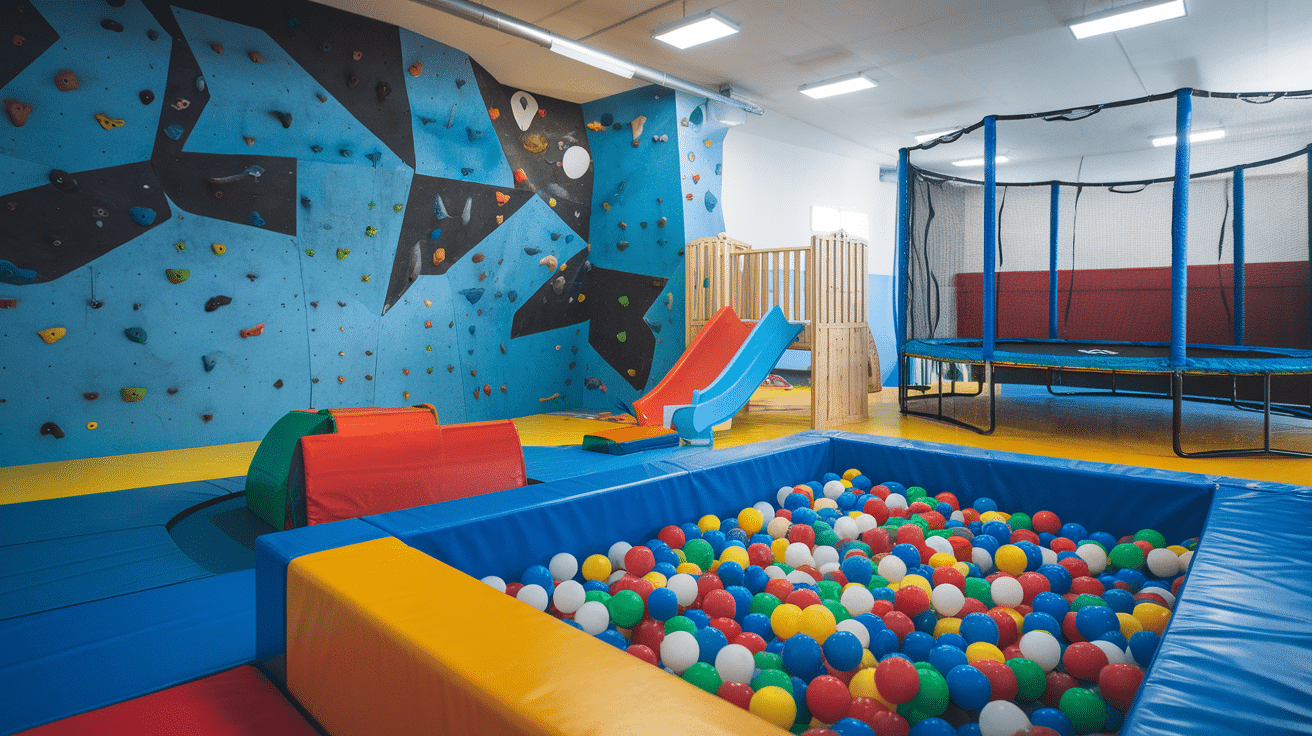
Check out creative activity ideas tailored for kids, teens, and adults, ensuring everyone can join in on the fun.
From simple games to more challenging tasks, these ideas are designed to engage and entertain all age groups.
Interesting Activities for Younger Kids (6-8 Years)
Engage kids ages 6-8 with interactive and exciting activities that promote teamwork, coordination, and learning.
These easy-to-follow games are perfect for keeping them active and entertained indoors or outdoors
16. Simon Says
In this game, one player (Simon) gives commands like “touch your nose” or “jump up.” Players must only follow the command if it starts with “Simon says.” If Simon doesn’t say it first, the players shouldn’t follow it.
If they do, they’re out. The game is easy, fun, and free to play since all you need is a group of people.
17. Craft Time
Give kids supplies like paper, glue, scissors, and markers to create their own projects. They can make cards, draw pictures, or build things from recycled materials.
This activity helps kids use their imagination and fine motor skills. Craft supplies typically cost around $5 to $15, depending on what materials you already have at home.
18. Scavenger Hunt
Create a list of items for kids to find around the house or yard. They might need to look for objects like a red ball, a spoon, or a leaf.
Players can work alone or in teams to find everything on the list. This game teaches kids how to follow instructions and observe carefully. You can do it for free using items already around your house.
19. DIY Obstacle Course
Set up an obstacle course using household items like chairs, pillows, or blankets. Kids can crawl under tables, jump over cushions, or walk along a line.
They race through the course to see who finishes the fastest. It’s a great way to burn energy and practice coordination.
You can set it up for free with what you already have, but you might spend about $5 to $10 if you decide to add more items like cones or tunnels.
20. Indoor Bowling
Create an indoor bowling lane by setting up plastic bottles or empty water bottles as pins and using a soft ball to knock them down.
Kids take turns rolling the ball and trying to knock over as many pins as possible. It’s a fun way to improve hand-eye coordination. You can create this game at home for free or buy a small bowling set for about $10.
21. Cup Stacking Challenge
Give kids plastic cups and see how fast they can stack them into a pyramid and then take them down. You can time them to see who does it fastest or make it a race between two players.
This game helps improve speed and hand-eye coordination. You’ll need a set of plastic cups, which usually cost around $5 to $10.
22. Balloon Pop
Before inflating balloons, place small pieces of paper inside with fun tasks like “dance for 10 seconds” or “do 5 jumping jacks.” Kids pop the balloons and do the tasks inside.
This game is exciting and helps burn off energy. Balloons typically cost $1 to $5, depending on the number you buy.
23. Color Sorting Race
Give kids a mix of colorful objects like buttons, blocks, or paper pieces and have them sort them by color as quickly as possible.
You can have them race against each other or time themselves to see who sorts the fastest. This game helps kids learn about colors and develop motor skills. It’s free if you use objects you already have at home.
24. Paper Plane Contest
Kids make their own paper airplanes and compete to see whose plane flies the farthest or stays in the air the longest.
You can set up challenges like accuracy, distance, or style. All you need is paper, which is inexpensive or free.
25. Hot Potato
In this game, kids sit in a circle and pass a ball or a beanbag while music plays. When the music stops, the person holding the “potato” is out.
The last person remaining wins. This game is fast-paced and fun for all ages. You can play it with any small object that costs less than $5 or is something you already have at home.
26. Hopscotch
Use tape to make a hopscotch grid on the floor. Kids take turns throwing a small object onto the grid and then hopping across it without stepping on the lines.
This game helps with balance and coordination. You only need tape and a small object (like a coin) to play. It’s free if you have tape at home.
27. Puddle Jumping (Indoor with Paper Plates)
Set up “puddles” using paper plates scattered around the room. Kids have to jump from one plate to another without stepping on the floor.
This game is perfect for burning energy and improving balance. The materials are simple: paper plates, which cost just a few dollars.
28. Balloon Rocket
Blow up a balloon and tape it to a string stretched across the room. When you let go of the balloon, it will zip across the string.
This simple game is a fun way to demonstrate basic science concepts like air pressure and movement. You just need a balloon, string, and tape, which cost around $5.
29. Cookie Decorating
Let kids decorate plain cookies with icing, sprinkles, candies, or anything else they like. This activity is a fun way for kids to be creative and practice fine motor skills.
You can buy basic decorating supplies for around $5 to $15, or you can use what you have at home.
30. Build a Fort
Use blankets, pillows, and chairs to build a fort. Once the fort is built, kids can hang out inside, read, or pretend it’s their secret hideout.
This activity promotes imagination and creativity. It’s free if you have blankets and pillows, or you can buy special fort-building kits for $10 to $30.
31. Story Time with Puppets
Create puppets out of socks or paper bags and let the kids come up with their own stories to tell with the puppets. This encourages creativity and storytelling.
You can buy puppets for $5 to $20 or make your own for free using materials you have at home.
32. Dance Party
Turn on some fun music and let the kids have a dance party. You can add challenges like freeze dance or limbo for extra fun.
This game is great for physical activity and helps kids improve coordination. It’s free as long as you have music and space to move.
Thrilling Indoor Activities for Older Kids (9-12 Years)
Keep older kids on their toes with exciting indoor activities that challenge their creativity and physical skills.
From scavenger hunts to obstacle courses, these games are designed to keep them engaged and entertained for hours
33. Laser Maze Challenge
To create a laser maze, use red yarn or string to form a crisscross pattern in a hallway or room. The challenge is for kids to navigate carefully through the “laser beams” without touching them.
You can make it more exciting by adding a timer or having kids compete to finish the maze the fastest. This activity improves balance and coordination.
The cost is minimal since you only need yarn or string, which costs about $5.
34. Escape Room Game
An escape room game involves solving puzzles and clues to “escape” a room before time runs out. You can either buy a pre-made kit or make your own by hiding clues and challenges around the room.
Kids must work together to solve the puzzles. It’s a great way to improve teamwork and problem-solving skills. Pre-made kits cost between $20 and $50, or you can create a DIY version with household items for free.
35. Indoor Rock Climbing
Indoor rock climbing lets kids climb walls with different difficulty levels, improving strength and coordination. If you have an indoor climbing gym nearby, kids can try climbing under safe supervision.
A day pass for rock climbing usually costs around $20 to $30 per child. If you’re setting up a small climbing wall at home, expect to spend anywhere from $100 to $500 for materials and installation.
36. Virtual Reality Adventure
A Virtual Reality (VR) adventure involves using a VR headset to experience interactive games or explore virtual environments.
It’s a fully immersive experience that makes it feel like you’re inside a different world. This is a great activity for kids who love technology and gaming.
VR headsets usually cost between $100 and $500, depending on the brand and system used.
37. Indoor Trampoline Park
Indoor trampoline parks have large trampolines where kids can jump, play games, or even do acrobatic tricks. Some parks have additional activities like foam pits, dodgeball courts, and basketball hoops.
This is a fun way to get exercise and burn off energy. A visit usually costs between $10 and $25 per child for an hour or two of jumping.
38. Mystery Dinner Party
A mystery dinner party involves kids taking on different characters and trying to solve a mystery by following clues during dinner.
Everyone gets a role to play, and they need to figure out who committed a fictional crime or uncover a hidden secret.
This activity helps improve problem-solving and teamwork. Mystery dinner kits cost around $15 to $30, or you can create your own with free printable scripts and props.
39. DIY Science Experiments
DIY science experiments involve fun and simple science activities using everyday household items. Examples include making a volcano with baking soda and vinegar or creating a homemade lava lamp.
These experiments help teach kids about scientific concepts in a fun way. The cost for materials is low, usually between $5 and $10 for basic items like baking soda, food coloring, and plastic bottles.
40. Video Game Tournament
In a video game tournament, kids compete against each other in multiplayer games to see who can score the highest or win the most rounds. You can choose from various game types, like racing, sports, or strategy games.
This is a great way for kids to improve their gaming skills. The cost depends on the game, with many titles ranging from $20 to $60, or there are free online games available, too.
41. Indoor Archery
Indoor archery involves shooting arrows at a target. There are special indoor archery sets with soft-tipped arrows that are safe for indoor use. It’s a great activity for improving focus and hand-eye coordination.
Archery sets typically cost between $20 and $50, depending on the brand and quality. Make sure to create a safe area for the activity.
42. Nerf Gun Battle
Nerf gun battles are exciting games where kids use Nerf blasters to shoot foam darts at each other. They can play in teams or individually, using obstacles to hide behind.
The goal is to eliminate opponents by hitting them with foam darts. Nerf guns cost between $10 and $40, depending on the model, and you can also buy extra dart packs for around $5.
43. Shadow Art Challenge
In this activity, kids use a light source like a flashlight to cast shadows on a wall or surface, then trace and turn those shadows into artwork.
They can use everyday objects like toys or their hands to create interesting shapes and designs.
This is a fun way to explore light and creativity. The cost is minimal if you have a light source and paper at home, making it a free activity.
44. Indoor Scavenger Hunt
An indoor scavenger hunt involves hiding items around the house and giving kids a list of things to find. They can work alone or in teams to see who can find all the items first.
It’s a fun and active way to engage kids while encouraging problem-solving. You can create this for free with items you already have around the house, or spend a small amount on small prizes or treasures.
45. Art and Graffiti Challenge
The art and graffiti challenge lets kids create their own murals or graffiti-style artwork using markers, spray bottles, or paint on large paper or cardboard.
You can give them a theme or let their creativity flow freely. This activity helps improve artistic skills and self-expression. Art supplies like markers, paints, and paper typically cost between $5 and $20.
46. Dance Battle
In a dance battle, kids show off their best dance moves to music. You can either compete individually or in teams. The goal is to outdance the other players, and the winner can be chosen by votes or performance.
It’s a fun and energetic way to get moving. All you need is music, so it’s a free activity if you already have a music player.
47. DIY Escape Room Puzzle
Create a DIY escape room at home by hiding puzzles, clues, and locks around a room. Kids will need to solve these challenges to “escape” or reach a hidden object.
This game encourages teamwork and problem-solving skills. The cost is low if you use household items, though you can buy printable escape room kits for around $10 to $30.
48. Indoor Zip Line (using a pulley system)
Set up a simple indoor zip line by attaching a pulley system to two points in a room (such as door frames). Kids can use a small seat or handle attached to the rope to zip from one point to another.
It’s an exciting activity that provides a thrilling experience indoors. Building an indoor zip line setup can cost between $50 and $100, depending on the materials you use.
49. Build a Rube Goldberg Machine
A Rube Goldberg machine is a complex contraption designed to perform a simple task in a creative way. Kids can use everyday items like dominoes, marbles, paper cups, and ramps to build a chain reaction.
This activity encourages critical thinking and problem-solving. The cost is minimal since you can use items around the house, though you may spend a few dollars if you buy extra materials like marbles or dominoes.
50. Laser Tag (with indoor set)
Laser tag is a fun game where kids use laser guns to tag opponents in a dark or dimly lit area. Each player wears a vest or sensor, and the goal is to “tag” others while avoiding being tagged.
You can buy an indoor laser tag set for the home, which typically costs around $30 to $50. It’s a great way to get kids moving and to engage in friendly competition.
51. Indoor Skating (if space allows)
If you have enough space at home, you can set up an area for indoor skating using roller skates or rollerblades. Make sure the floor is smooth and clear of obstacles.
Skating is a great way for kids to build coordination and balance. You can buy roller skates for around $20 to $50, and it’s a fun way to stay active indoors.
How Can Kids Aged 6-12 Stay Active Indoors
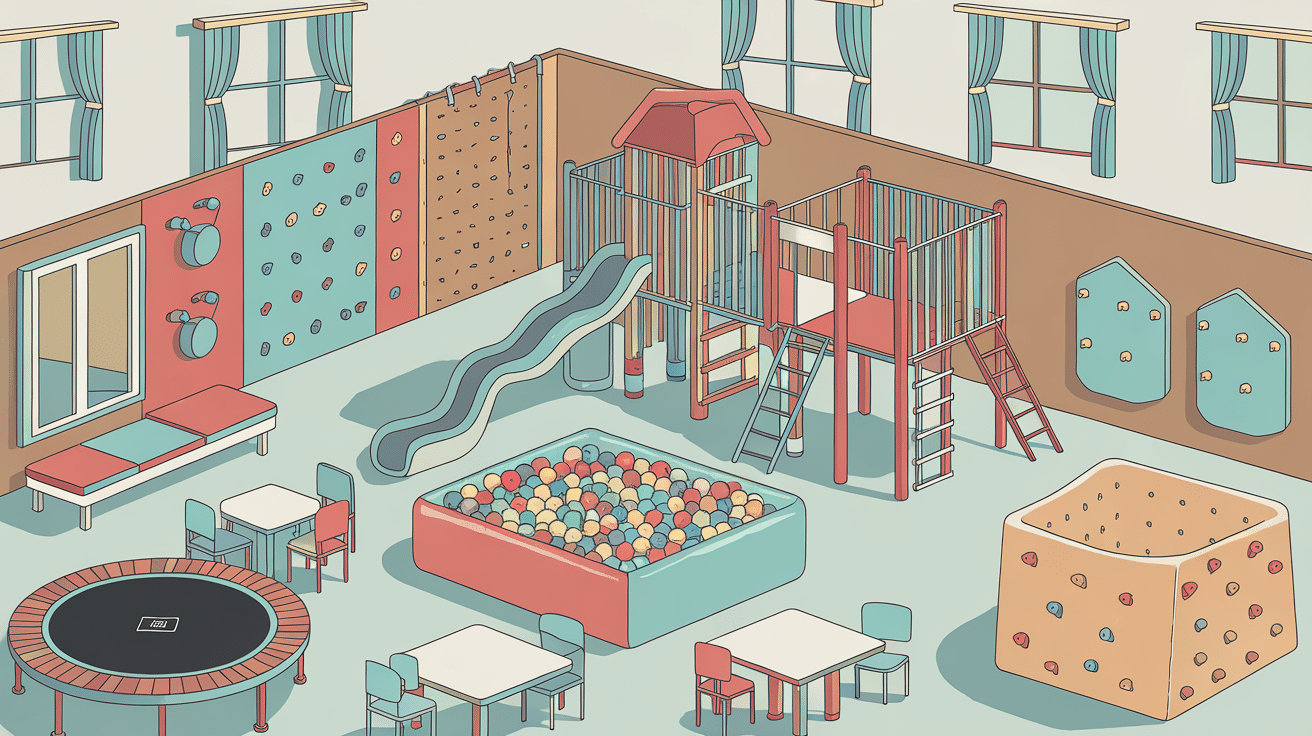
When outdoor play isn’t possible, these indoor activities keep kids moving and engaged:
Quick Movement Games
- Hallway bowling: Use plastic bottles as pins and any soft ball
- Balloon volleyball: Keep balloons from touching the ground using hands, feet, or heads
- Living room obstacle course: Time kids as they navigate under tables, around chairs, and over pillow “mountains”
- Dance challenges: Create a 30-second choreography or follow dance tutorials online
Skill-Building Activities
- Sock basketball: Roll socks into balls and use laundry baskets as hoops
- Masking tape balance beam: Create straight lines, curves, or shapes on the floor to walk along
- Indoor scavenger hunts: Hide items throughout the house that kids must find while hopping, crawling, or tiptoeing
- Fitness dice: Write different exercises on paper dice and roll to determine the activity
Structured Movement
- 15-minute yoga sessions: Animal poses particularly engage this age group
- Circuit training: Create 5 stations with different movements at each (jumping jacks, wall push-ups, etc).
- Indoor “recess” games: Simon Says, Red Light/Green Light, or Follow the Leader
The most effective indoor activities for this age group last 15-20 minutes, incorporate elements of fun or competition, and require minimal setup.
Rotating between activities prevents boredom while ensuring kids get the 60 minutes of daily physical activity recommended by pediatricians.
The Bottom Line
Indoor physical activities for 6-12-year-olds aren’t just about burning energy—they’re about building healthy habits that last a lifetime. The games and movements we’ve shared help children develop coordination, strength, and confidence while having fun.
So what’s your next step? Pick three activities from our list that match your child’s interests and your available space. Start small and build your indoor activity toolkit gradually.
Remember that your participation matters, too. When you join in occasionally, you show kids that staying active is a family value.
Ready to get started? The best indoor activity is the one that gets your child moving right now. No special equipment is needed, just your creativity and their enthusiasm.

